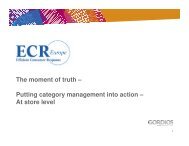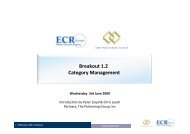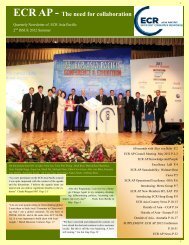You also want an ePaper? Increase the reach of your titles
YUMPU automatically turns print PDFs into web optimized ePapers that Google loves.
8.3. Choosing the Right Unit Loads<br />
System<br />
As discussed earlier, there are two main drivers of Unit<br />
Loads Efficiency:<br />
• Those which maximise utilisation of available<br />
space<br />
• Those which minimise handling along the<br />
chain.<br />
There is no universal solution as impact differs by<br />
category and type of product flow.<br />
Figure 29: Efficiency drivers differ by category and product flow<br />
fast-mover<br />
Business<br />
volume<br />
(number<br />
per day)<br />
slow-mover<br />
small<br />
Handling<br />
efficiency<br />
Increased<br />
need for<br />
Source: A.T. Kearney, Efficient Unit Loads project<br />
Transport<br />
space<br />
utilisation<br />
Storage<br />
space<br />
utilisation<br />
Item volume (Number per m 3 )<br />
Understanding key cost drivers can be helpful in<br />
identifying major deficiencies in current flow<br />
structures.<br />
A real breakthrough requires a radical review and a<br />
greenfield redesign, considering the potential impact<br />
of ER. This could result in:<br />
• More frequent deliveries<br />
• Smaller delivery lot sizes<br />
• Less volume volatility<br />
• Reduced ‘in-chain’ stocking<br />
• Increased cross-docking<br />
bulky<br />
Taking a total process view, EUL need to be tailored to<br />
suit a specific type of material flow.<br />
The Efficient Unit Loads Report 57










